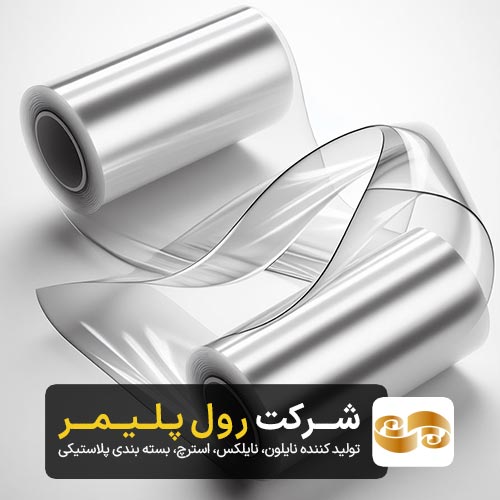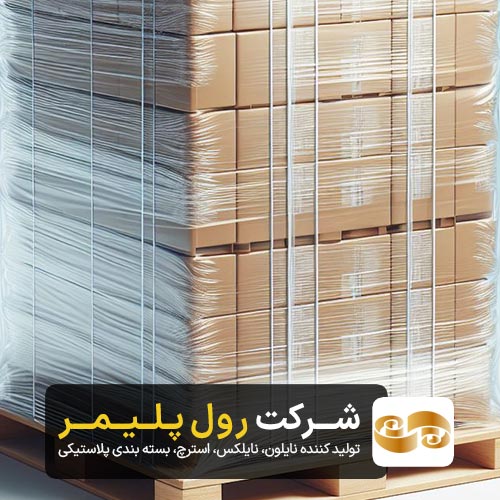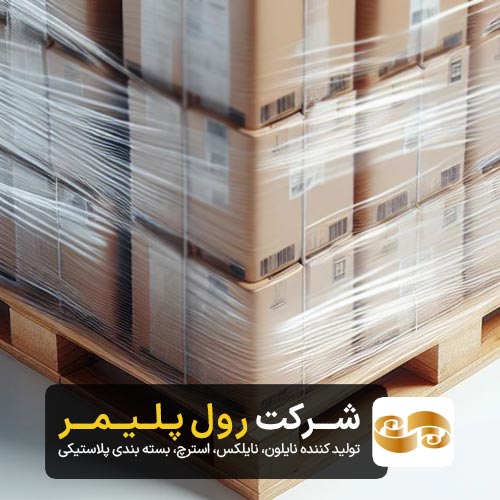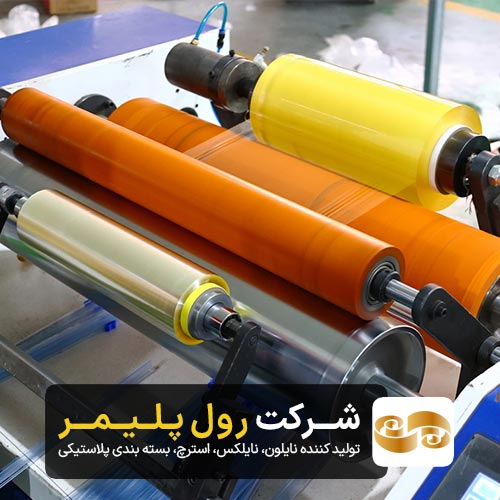
Stretch Films Manufacturing
At every stage of production, in Roll Polymer factory, strict quality control is carried out so that the stretch film produced is compatible with international standards and meets the needs of customers well.
Types of stretch nylon and their uses
- Normal stretch nylon:
- Application: packaging and protection of all kinds of goods and products in warehouses and during transportation.
- Example: packing cardboard packages, loading pallets, electronic devices and…
- Nylon stretch anti-penetration:
- Application: use in food and pharmaceutical industries to maintain the cleanliness and safety of products against contamination and infiltration through air and pollution.
- Example: food packaging, pharmaceutical and cosmetic products, etc.
- Stretch nylon with thermal stability:
- Application: packaging of products that need to maintain temperature and heat, such as military products, pharmaceutical and chemical industries.
- Example: packaging of pharmaceutical raw materials, medical products, etc.
- Waterproof stretch nylon:
- Application: packaging and protection of products against water, moisture and humid air.
- Example: packing fresh and fresh food and protecting electronic products in humid environments.
- Stretch nylon with anti-flex properties:
- Application: packaging of products that need to maintain shape and structure.
- Example: packing furniture, wooden items, glass items, etc.
- Stretch nylon with anti-UV properties:
- Application: packaging products that need to maintain color and quality against direct sunlight.
- Example: packaging of agricultural products, food with natural color and…
- Anti-pollution stretch nylon:
- Application: packaging of products that do not need to maintain cleanliness and pollution.
- Example: packaging of electronic products, cosmetics, etc.

Different raw materials such as low density polyethylene (LLDPE) or high carbon polyethylene (HDPE) are used to produce stretch film.These raw materials are mainly used to improve the flexibility, strength and elasticity of stretch film. The use of different raw materials in the production of stretch film can have a direct effect on the final thickness of the film. For example, the use of low density polyethylene (LLDPE) usually gives the stretch film more flexibility and can reduce its final thickness. On the other hand, the use of high-carbon polyethylene (HDPE) may give the stretch film more resistance and strength, which may lead to an increase in its final thickness. Therefore, the type of raw materials used in the production of stretch film can directly affect the thickness and other characteristics of the film.

Stretch pallet strap
- Flexibility: Due to its high flexibility, this film is easily placed on various objects, including asymmetrical or irregularly shaped loads.
- Strength: The stretch pallet strap has a suitable strength that securely fixes heavy loads on the pallet and prevents them from falling or being damaged.
- Durability: This film has high resistance and durability, which allows for the preservation of loads during long transportation distances.
- Stretchability: Stretch pallet strap has high elasticity, which can easily be stretched to the required size from different loads.
- Resistance to environmental conditions: This film is resistant to various environmental conditions, including humidity, heat and cold, which ensures the preservation of the quality of loads during transportation.
- Various applications: Stretch pallet band is used in various industries including food industry, automotive industry, electronic and pharmaceutical industries.
- Ease of use: This film is easily placed on loads by automatic or manual devices and can be easily cut and packaged using appropriate tools.
Polymer additives to change the properties of stretch film
- Anti-Fog: This additive prevents the formation of fog and steam on the surface of the film, which makes the loads stay clear during transportation.
- Anti-UV (Anti-UV): This additive prevents the nylon stretch film from getting damaged and aging by absorbing and blocking the ultraviolet rays of the sun.
- Anti-Static: This additive is used to prevent the accumulation of static electricity on the film and eliminate risks such as the absorption of dust particles.
- Antibacterial (AB): This additive helps to improve the hygiene and productivity of products by destroying and controlling the growth of bacteria and microbes on the surface of the film.
- Ethylene Vinyl Acetate (EVA): This additive acts as an anti-embrittlement agent in nylon stretch film and prevents the film from tearing and breaking during transportation.
- Anti-IR: By absorbing and preventing infrared radiation, this additive prevents unwanted heating of loads inside the package and maintains their quality.< /li>
In addition to the additives mentioned, there may be other additives for stretch that are used to improve certain properties such as water resistance, increased adhesion, increased flexibility, heat resistance or other physical and chemical properties.

Comparison of stretch nylons based on raw materials and thickness
raw materials used in the production of stretch nylons in roll polymer factory on the elasticity and efficiency of these products They have an important effect, and for this reason, the company’s engineers constantly monitor the quality of the products and check the standards required by the customers at each stage and deliver the final product according to the customer’s request. In fact, the tensile properties of stretch nylons mostly depend on factors such as the type of raw materials, production method, thickness and variety of polymer materials used. In general, polymer materials such as medium density polyethylene (MDPE), high density polyethylene (HDPE), rhombic polyethylene (LLDPE) and metallocene are among the materials used to produce stretch nylons.
- Plasticity of materials: Plasticity materials used in the composition of stretch nylons have a significant effect on their flexibility and elasticity. Materials such as LLDPE and Metallocene are preferred for the production of high-performance stretch nylons due to their high flexibility and better elasticity.
- Nylon thickness: The thickness of stretch nylons also affects their elasticity. Nylons that are produced with greater thickness usually have more resistance and elasticity.
- Production method: The production process can also affect the elastic properties of stretch nylons. The applied processing methods can be effective in improving the final quality and elasticity of the product.
- Other variables: Other factors such as the amount of additives, material formulation and production process conditions can also affect the elasticity of stretch nylons.
| Name | raw materials | thickness (micron) | Width (cm) | Length (meters) | Color | Strength rate (%) |
| Stretch film by LLD Group | LLDPE | 23 | 50 | 1000 | White | 150 |
| LD stretch films | LDPE | 30 | 75 | 1500 | Black | 200 |
| Stretch Metallocene LLDPE | Metallocene LLDPE | 15 | 100 | 2000 | Transparent | 180 |
Technical characteristics of stretch films
| SI | FPS | |
Tensile Strength | MD | 10-24 MPa | 1500-3500 psi |
CD | 8-13 MPa | 1200-2000 psi | |
Elongation | MD | 150-200 % | 150-200 % |
CD | 350-400 % | 350-400 % | |
Permeability (OTR) | 35000 ml/m² per 24 hrs | 2260 cc / 100 in² / 24 hrs | |
WVTR | 115 g/m² (24 hrs) | 7.42 g / 100 in² /24 hrs | |
Food Safety Compliance regulations | Meets the latest food contact regulations as per EU directive no.10/2011 (Ref.2002/72/EEC) | Meets the latest food contact regulations as per FDA – 21 CFR 177.1520 | |
Follow us on social networks
Characteristics and applications of stretch films
- High flexibility: High quality stretch films have high flexibility that allows them to be stretched and wrapped easily. This feature allows the stretch film to be easily stretched and closed on objects to the desired size.
- High strength: Quality stretch films are produced from high strength materials that increase resistance to pressure, tension and other mechanical stresses. This resistance prevents the stretch film from tearing or getting punctured during transportation and storage.
- Proper Adhesion: Quality stretch films have good adhesion that effectively adheres to various surfaces and prevents easy separation from loads.
- Resistance against breaking and tearing: The quality of the stretch film means having a high resistance against breaking and tearing. This feature makes the stretch film organize the transport of loads safely.
- Resistance to tears caused by holes and weak areas: Quality stretch films have high resistance to tears caused by holes and weak areas. This feature makes the stretch film completely cover loads and prevent leakage and external penetration.
- High stretchability: Quality stretch films have high stretchability, which allows them to be wrapped around different goods, making loads tightly and securely wrapped.
- Proper packaging: Quality stretch films are provided in proper packaging that prevents contact with pollution, moisture and other damages.
- Industrial cargo packaging: The main use of stretch film is in the packaging and protection of industrial cargo. These films are used to wrap and cover all kinds of loads, including large pallets, cartons, furniture seats, electronic devices, etc.
- Maintenance and transportation of goods and furniture: Stretch film is used to maintain the safety and strength of the transported goods and also to prevent the transfer of dust and moisture to the goods during transportation.< /li>
- Packaging food products: In the food industry, stretch film is used to package a variety of products, including fruits, vegetables, bread, meat pieces and other food items, to prevent contact with air and contamination. And preserve the freshness of the products.
- Usage in agricultural industries: In agricultural industries, stretch film is used for packaging and preserving trust and preventing damage to agricultural products, especially during transportation and storage. li>
- Usage in the pharmaceutical and medical industries: In the pharmaceutical and medical industries, stretch film is used to package and protect sensitive products such as drugs, medical devices, and surgical instruments.
- Usage in the construction industry: In the construction industry, stretch film is used for packaging and protection of construction materials such as tiles, flooring and kitchen appliances during transportation and installation. >
- Usage in the automotive industry: In the automotive industry, stretch film is used for packaging and protection of internal and external parts and accessories of cars during transportation and storage.
- Packaging and preservation of food safety: One of the main uses of stretch film at home is packaging and preservation of food safety. This film can be used to wrap food bags, leftover food containers, vegetables and fruits, and even containers for storing cooked foods to prevent contact with air and pollution and preserve the freshness of foods.
- Protecting familiar items: Stretch film is used to protect familiar items such as books, kitchen utensils, children’s toys, etc. against dust, moisture and pollution.
- Packaging and transportation of goods: This film can be used for packing and transportation of various goods such as store-bought items, toys, electrical and electronic appliances, etc., to prevent damage and Avoid damage during transportation.
- Packaging and preservation of seasonal products: Stretch film can be used to package and preserve seasonal products such as winter clothes, seasonal sports equipment, children’s equipment, etc. when they are not in use.
- Usage in craft and artistic professions: Artists and art designers may use stretch film to create special effects and designs in their artistic practices.
- Usage in educational and educational work: In some cases, stretch film can be used to conduct experiments and educational and educational projects in schools and colleges.
Classification of stretches based on customer needs
Stretch pallet band is one of the vital tools in the field of packaging and transportation of industries and goods. This film is a type of pallet used to pack various loads. By using stretch pallet strap, loads are tightly and securely packed on pallets so that they are not damaged during transportation and prevent damage. This film becomes integrated and strong by stretching on the loads and pallets and makes the loads more stable and strong. In addition, the use of stretch pallet bands provides improvement in warehouse management and increased productivity during transportation.
Food industry stretch is a type of stretch film that is especially used in the food industry. This type of stretch film, in addition to the general characteristics of stretch films such as flexibility, stretchability, and strength, has special characteristics that are very important for food storage and packaging. Food stretch is commonly used as primary packaging for food products such as fruit, vegetables, meat, fish, bread, dairy, and frozen products. Due to its flexibility and safety features, this film preserves freshness, reduces waste, and increases the useful life of food. The use of stretch in the food industry is also done in order to prevent the penetration of air, moisture, and contamination into food products, which is very vital in terms of hygiene.
- Furniture packaging: Using stretch furniture for furniture packaging completely protects it and prevents damages and injuries caused by transportation and storage.
- Protection in storage: Using stretch furniture in warehouses and furniture warehouses as a protective layer helps to protect the furniture from dust, moisture and other damages.
- Preventing parts from being released: Stretch furniture can be used as a strong layer to prevent different pieces of furniture from being released and separated during transportation.
- Protection during the production process: In the furniture production process, the use of stretch furniture can be used as a protective layer to protect the products against various risks.
- Usage in stores: Stretch furniture is used for packaging and protecting furniture in stores and exhibitions so that the products are not exposed to various damages and losses during storage. >
Frequently asked questions before ordering stretch
How should we use stretch for pallet packaging?
- Pallet preparation: Before packing, make sure the pallet is properly prepared. Ensure that the goods are placed on the pallet in an orderly and horizontal manner and that no part of them falls out of the edge of the pallet.
- Start packing: Start packing by placing the first stretch on the pallet. This will ensure that the stretch is properly attached to the pallet and the packaging will be more secure.
- Stretch wrapping: After the initial placement, gently wrap the stretch around the pallet and adjust as much as possible so that the goods are completely enclosed and there are no gaps.
- Strengthening sensitive points: If there are sensitive or vulnerable points, using stretch to strengthen and stabilize these points is very useful. You can cross the stretch through these points and strengthen the packaging.
- End of packing: After the stretch wrap is completely wrapped around the pallet, close it with tapes or stretch locks and make sure the packing is done safely and tightly.
- Final inspection: Finally, check the packed pallet and make sure that the goods are properly packed and there are no weak points or imperfections.
How do they calculate the price of stretch films and what factors are effective in pricing?
The price of stretch films is usually calculated by manufacturers or suppliers and is influenced by the following factors:
- Raw materials: The type and quality of raw materials used in the production of stretch film is very important. Stretch films are usually produced using polyethylene (PE), but the difference in quality and stability of raw materials can affect the price.
- Film thickness: Film thickness is one of the basic factors in determining the tensile strength and resistance of stretch film. Thicker films usually have a higher price, because they have more resistance and stability.
- The width and length of the film: The dimensions of the stretch film can also affect its price. Films with larger dimensions are usually more expensive.
- Special features: Some stretch films have special features such as anti-UV, waterproof, anti-static, etc., which may increase the price.
- Application: the type of application and purpose of using stretch film can also affect its price. For example, stretch films for food packaging may have a higher price.
- Demand and supply: The rate of demand and supply of stretch films in the market can also be influential. When the demand is greater than the supply, the price usually increases and vice versa.
Can it be printed on stretch fabric?
Yes, stretch film can be printed. This printing is usually to display the logo, slogan, contact information or other required information on the packaging. Printing on stretch film can be done by flexography, offset, silk screen or other printing methods. This application can help in advertising and branding of products and also display the required information for customers.
Do the stretchers have colors?
Yes, stretchers are also usually available in different colors. These colors may be used to differentiate between different loads or to quickly and effectively identify package contents. Also, the coloring of the stretchers can help with advertising and branding.
